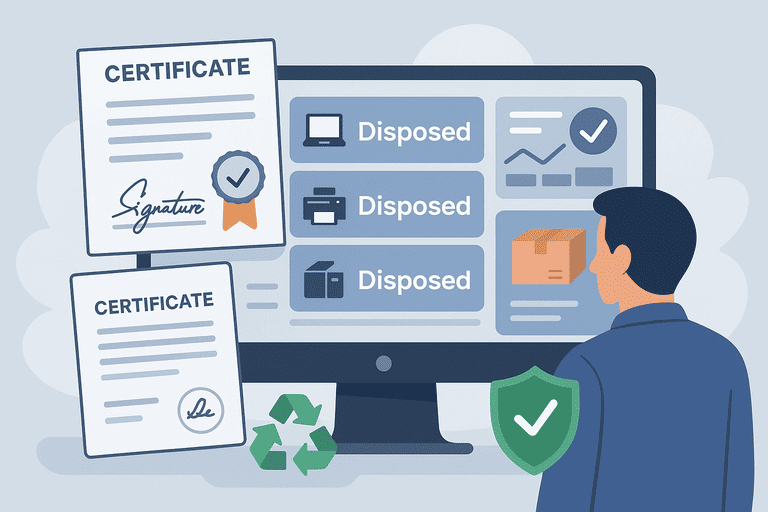Auditable Asset Disposals: Clean Records & Certificates
Learn how to manage auditable asset disposals, generate disposal certificates, and maintain traceability across financial, compliance, and sustainability workflows.

Introduction
Disposing of business assets isn’t as simple as throwing them away.
Every asset — from laptops to lab machines — leaves behind a financial, legal, and environmental footprint.
An auditable disposal process ensures that every asset’s end-of-life is properly recorded, authorized, and verifiable — protecting both your organization and your compliance posture.
1. Why Asset Disposals Need to Be Auditable
Asset disposals are often overlooked, yet they represent a critical compliance phase of the asset lifecycle.
Key reasons to maintain auditable records:
- Financial accuracy: Disposals affect depreciation, balance sheets, and tax filings.
- Data security: Sensitive data (especially on IT equipment) must be sanitized and certified.
- Environmental compliance: Certain industries require proof of responsible recycling or waste management.
- Insurance and liability: Audit trails protect against disputes and fraud.
Without structured documentation, organizations risk fines, reporting errors, and lost accountability.
2. The Core Steps in an Auditable Disposal Workflow
| Step | Description | Document Output |
|---|---|---|
| 1. Identification | Flag asset as obsolete or non-functional. | Disposal request form |
| 2. Authorization | Manager or finance approval. | Approval record |
| 3. Sanitization | Secure data wipe or material handling. | Data destruction certificate |
| 4. Physical Disposal | Vendor pickup, recycling, or donation. | Proof of collection / receipt |
| 5. Financial Closure | Update depreciation and write-offs. | Disposal ledger entry |
| 6. Certification | Final compliance document linking all above steps. | Disposal certificate |
Every record should be digitally signed, timestamped, and linked to the asset’s unique ID or QR tag.
3. Disposal Certificates: What They Should Contain
An effective disposal certificate provides proof of process and meets both internal audit and regulatory standards.
Must-have fields:
- Asset ID and category
- Serial number or QR code reference
- Disposal reason (obsolete, damaged, upgraded)
- Authorization date and approver
- Vendor details and method of disposal
- Environmental / data destruction certificates attached
- Final value write-off or recovery
These details create a clear, defensible record that can be retrieved during audits or inspections.
4. Linking Disposal Data to Financial and Compliance Systems
A well-designed asset management system connects disposal workflows directly with:
- Accounting software (e.g., Xero, QuickBooks) for depreciation and write-off synchronization.
- Environmental compliance portals for recycling or e-waste reporting.
- Internal audit dashboards for traceability and control reviews.
By integrating disposal data across these platforms, organizations reduce duplication and strengthen transparency.
5. Common Disposal Scenarios
- IT Equipment: Requires certified data destruction and hardware recycling documentation.
- Machinery and Tools: Needs proof of sale, transfer, or scrap certification.
- Furniture and Fixtures: Typically involves donation records or bulk disposal approval.
- Leased Assets: Must include return condition reports and vendor receipts.
Each disposal type may have different certificate templates — but all should align with your corporate retention and audit policies.
6. Best Practices for Maintaining Clean Disposal Records
✅ Use unique disposal IDs linked to original asset records.
✅ Require digital signatures for all approvals.
✅ Store all documents centrally — receipts, certificates, photos.
✅ Audit records annually for completeness.
✅ Retain records for 5–7 years, depending on jurisdiction.
A “clean” record means that any auditor can trace an asset’s journey — from purchase to disposal — without gaps.
7. Environmental and ESG Reporting Value
Transparent disposal management supports sustainability and ESG metrics.
Metrics to track:
- % of assets responsibly recycled
- % of IT equipment securely sanitized
- Recovery value vs disposal cost
- CO₂ emissions offset by donation or reuse
Such metrics can be exported into sustainability reports or annual compliance disclosures.
8. Future Trends: Blockchain and Verified Disposal Trails
Emerging solutions leverage blockchain-style ledgers for immutable disposal records.
These systems ensure that:
- Disposal vendors can’t alter records post-signature.
- Certificates remain verifiable across third parties.
- Auditors can instantly confirm authenticity and timestamps.
This is the next step toward tamper-proof compliance for high-value or regulated industries.
Conclusion
Auditable asset disposals aren’t just about paperwork — they reflect the discipline and accountability of your organization.
A proper disposal workflow ensures financial accuracy, data security, and environmental responsibility.
Every end-of-life asset should leave a traceable, certifiable digital footprint — because compliance doesn’t end at acquisition.
Explore related topics: